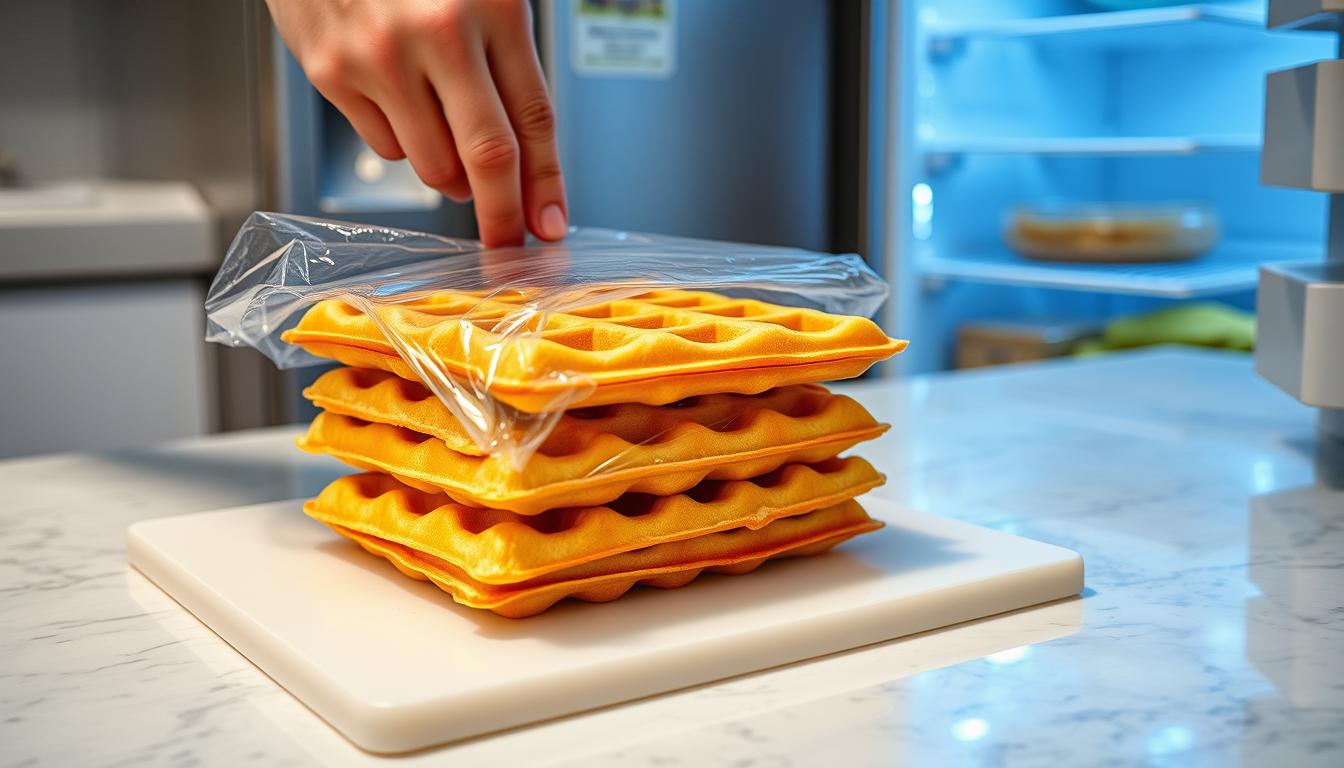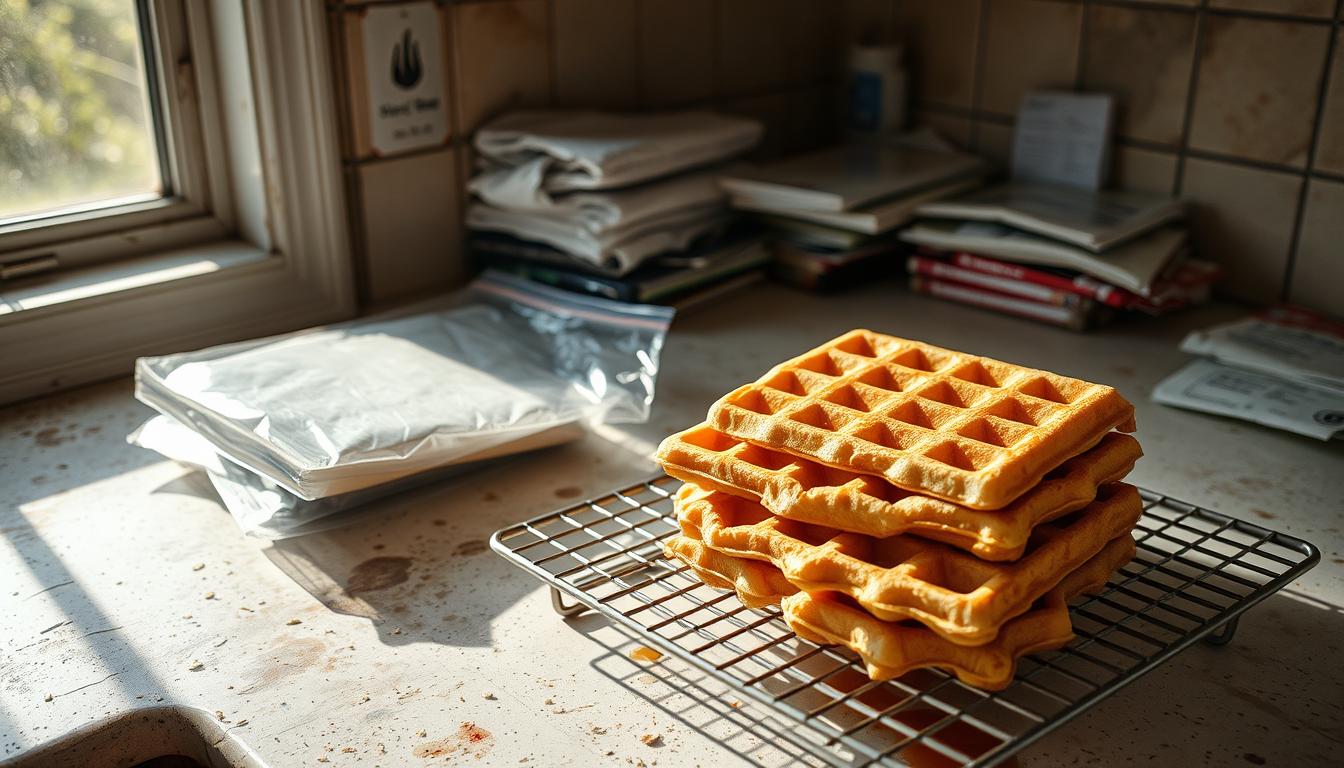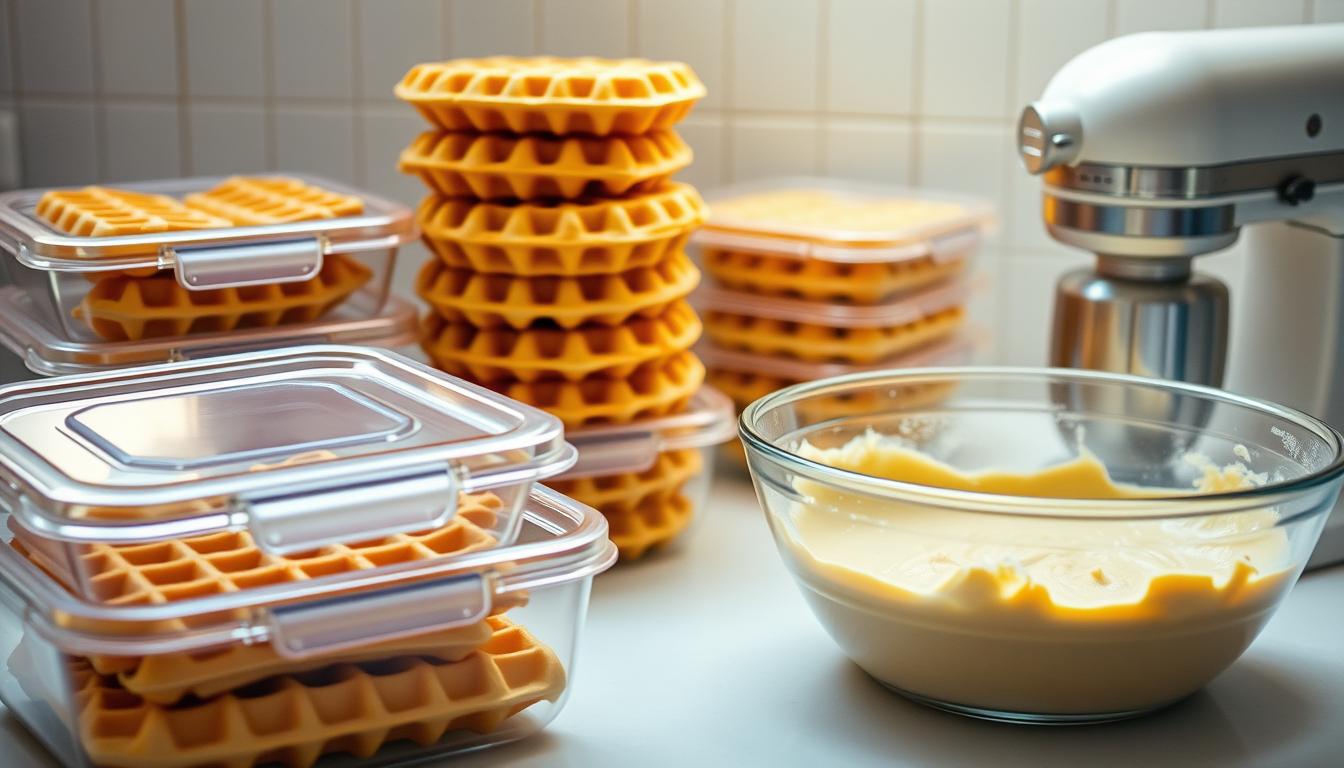Have you ever found yourself with leftover waffles and wondered if it’s safe to refreeze them? Refreezing waffles can be a convenient way to enjoy them later, but it’s crucial to do it correctly to maintain their quality and safety.

Refreezing waffles is a common query among breakfast enthusiasts. The process involves understanding the initial freezing process, the thawing method, and how to refreeze them without compromising their taste and texture.
Key Takeaways
- Understanding the safety of refreezing waffles
- Best practices for refreezing waffles
- Tips for maintaining waffle quality
- How to thaw and refreeze waffles correctly
- The impact of refreezing on waffle texture and taste
The Basics of Waffle Freezing
The process of freezing waffles is straightforward and offers several benefits. Freezing is a great way to preserve waffles for future meals, whether they’re homemade or store-bought. By understanding the basics of waffle freezing, you can enjoy your favorite breakfast food at any time.
Why People Freeze Waffles
People freeze waffles for various reasons, primarily to extend their shelf life and maintain freshness. Freezing waffles allows you to stock up on your favorite breakfast food without worrying about it going bad. It’s also a convenient way to plan meals in advance, saving you time during busy mornings. By freezing waffles, you can enjoy a quick and easy breakfast by simply toasting or microwaving them when needed.
Common Concerns About Frozen Waffles
Some common concerns about frozen waffles include the potential loss of texture and flavor. However, when done correctly, freezing can preserve the quality of waffles. It’s essential to follow proper freezing and thawing techniques to maintain the best possible taste and texture. Understanding how to freeze and thaw waffles properly is key to enjoying them at their best.
Can You Refreeze Waffles? The Definitive Answer
If you’ve ever found yourself with more waffles than you can eat before they go bad, you might wonder if refreezing is an option. Refreezing waffles can be a convenient way to preserve them for later use, but it’s crucial to understand the implications of this process.
Food Safety Considerations
When considering refreezing waffles, the first concern is food safety. Generally, if waffles have been thawed properly in the refrigerator and have not been left at room temperature for too long, they can be refrozen. However, it’s essential to inspect them for any signs of spoilage before refreezing. Check for unusual odors, slimy texture, or mold. If you notice any of these signs, it’s best to err on the side of caution and discard the waffles.
The safety of refreezing also depends on how the waffles were initially frozen and thawed. If they were thawed in the refrigerator and kept at a consistent refrigerator temperature, refreezing is generally safe. However, if they’ve been thawed at room temperature or have been cooked after thawing, the risk of bacterial growth increases, making refreezing less safe.
Quality Impact of Refreezing
Refreezing waffles not only raises safety concerns but also affects their quality. Each freeze-thaw cycle can degrade the texture and flavor of waffles. When waffles are frozen, the water inside forms ice crystals that can damage the structure of the waffle, making it soggy or crumbly upon thawing. Refreezing can exacerbate this effect, potentially leading to an unappealing texture.
Moreover, the flavor of waffles can also be impacted. Freezing and thawing can cause the waffles to lose some of their original taste and aroma. While refreezing itself might not significantly alter the flavor, the cumulative effect of multiple freeze-thaw cycles can result in a less flavorful product.
Different Types of Waffles and Their Freezing Properties
The freezing properties of waffles can vary greatly depending on their type and composition. This variability affects not only how well they freeze but also how they retain their texture and flavor after thawing. Understanding these differences is crucial for optimal waffle storage.
Store-Bought Frozen Waffles
Store-bought frozen waffles are designed to withstand freezing temperatures. They typically have a longer shelf life due to preservatives and specific packaging. When refreezing, ensure they remain at 0°F (-18°C) or below. You can follow the package instructions for thawing and reheating.
Homemade Waffles
Homemade waffles, lacking the preservatives found in commercial products, require more careful handling. To freeze homemade waffles effectively, cool them completely before placing them in airtight containers or freezer bags. This helps prevent moisture buildup, which can affect texture and quality.
Belgian vs. Regular Waffles
Belgian waffles, with their deeper pockets and denser batter, tend to freeze and thaw differently than regular waffles. They retain moisture better, which can be advantageous. However, this density also means they might require slightly longer reheating times.
Specialty Waffles (Gluten-Free, Vegan, etc.)
Specialty waffles, such as gluten-free or vegan waffles, have unique ingredients that can affect their freezing properties. Gluten-free waffles might become more crumbly after freezing and thawing, while vegan waffles could retain moisture differently due to their egg and dairy substitutes.
| Waffle Type | Freezing Characteristics | Reheating Tips |
|---|---|---|
| Store-Bought Frozen | Long shelf life, preservative-rich | Follow package instructions |
| Homemade | Requires airtight storage | Reheat in toaster or oven |
| Belgian | Dense, retains moisture well | May require longer reheating |
| Specialty (Gluten-Free, Vegan) | Variable texture changes | Check texture before serving |
By understanding the specific freezing properties of different waffle types, you can apply the best practices for waffle storage. This includes proper packaging, maintaining consistent freezer temperatures, and being mindful of the waffle type when reheating. Following these waffle storage tips will help you enjoy your waffles at their best quality, even after freezing and reheating.
The Proper Way to Freeze Waffles Initially
To keep your waffles fresh for a longer period, it’s essential to follow the proper freezing technique. This not only ensures they remain in good condition for potential refreezing but also maintains their taste and texture.
Cooling Before Freezing
Before freezing your waffles, it’s crucial to cool them down completely. This step is vital because it prevents the formation of ice crystals that can damage the waffle’s texture. Cooling on a wire rack allows air to circulate around each waffle, speeding up the cooling process.
Packaging Methods
Once your waffles are cooled, the next step is to package them appropriately. You can use airtight containers or freezer bags to store your waffles. When using freezer bags, make sure to press out as much air as possible before sealing to prevent freezer burn. For added protection, you can also wrap each waffle individually in plastic wrap or aluminum foil before placing them in a bag or container.

Organization in Your Freezer
Proper organization in your freezer is key to maintaining the quality of your frozen waffles. Store them in a way that allows you to see what you have at a glance, and make sure to label your containers or bags with the date they were frozen. This way, you can easily keep track of how long they’ve been stored and ensure you use the oldest items first.
By following these steps, you can enjoy your waffles at a later time while maintaining their quality. Proper initial freezing is a crucial step in the waffle freezing guide, and when done correctly, it makes a significant difference in the taste and texture when you’re ready to freeze and thaw waffles.
How to Safely Thaw Frozen Waffles
To enjoy your frozen waffles at their best, it’s essential to understand the proper thawing techniques. Thawing frozen waffles correctly is crucial for maintaining their texture, flavor, and overall quality. You can thaw frozen waffles using several methods, each with its own benefits.
Refrigerator Thawing
One of the safest ways to thaw frozen waffles is by placing them in the refrigerator overnight. This method allows for a slow and even thaw, helping to preserve the waffles’ texture. Simply place the waffles in a covered container or zip-top bag to prevent moisture from affecting other items in your fridge.
Countertop Thawing
If you need to thaw waffles more quickly, you can leave them on the countertop at room temperature. It’s essential to keep them in a covered container to prevent drying out or contamination. This method is faster than refrigerator thawing but requires more attention to prevent bacterial growth.
Direct Cooking Methods
For a quicker option, you can cook frozen waffles directly without thawing them first. Using a toaster or toaster oven is a convenient way to go straight from frozen to ready-to-eat. This method not only saves time but also helps retain the waffles’ crispiness. When reusing frozen waffles, consider the cooking method that best suits your needs.
By choosing the right thawing method, you can enjoy your frozen waffles while maintaining their quality. Whether you’re thawing for later use or cooking directly, understanding these methods ensures you’re making the most of your frozen waffles.
- Refrigerator thawing for a slow and safe thaw
- Countertop thawing for a quicker option
- Direct cooking for convenience and crispiness
The Refreezing Process: Step-by-Step Guide
The process of refreezing waffles requires attention to detail to maintain their quality and safety. When done correctly, refreezing can be a convenient way to enjoy your waffles over a longer period. You need to understand the conditions that make refreezing safe and the steps involved in the process.
When Refreezing Is Safe
Refreezing waffles is safe under certain conditions. If the waffles have been thawed in the refrigerator and have not been left at room temperature for an extended period, they can be refrozen. It’s essential to check the waffles for any signs of spoilage before refreezing, such as an off smell or visible mold.
You should also consider the time the waffles have spent in the thawed state. The sooner you refreeze them after thawing, the better. Generally, if waffles have been thawed in the refrigerator, they can be safely refrozen within a day or two.
Proper Refreezing Techniques
To refreeze waffles properly, you should follow a few key steps. First, ensure the waffles are cooled completely if they have been cooked or reheated after thawing. Then, place them in an airtight container or freezer bag, making sure to remove as much air as possible before sealing to prevent freezer burn.
Label the container or bag with the date and contents. If you’re stacking waffles, consider placing parchment paper between them to prevent sticking. Finally, store them in the freezer at 0°F (-18°C) or below.
| Refreezing Method | Benefits | Precautions |
|---|---|---|
| Airtight Containers | Protects from freezer burn, keeps fresh | Ensure containers are airtight |
| Freezer Bags | Space-efficient, easy to label | Remove as much air as possible |
| Parchment Paper Separation | Prevents waffles from sticking together | Use between waffle layers |
Labeling and Tracking
Labeling your refrozen waffles is crucial for keeping track of how long they’ve been stored. Use a marker to write the date and contents on the container or bag. This practice helps ensure you use the oldest items first and keeps you aware of what you have in storage.
By following these steps and guidelines, you can safely refreeze your waffles, maintaining their quality and extending their shelf life. Remember, the key to successful refreezing is attention to detail and proper storage techniques.
Common Mistakes When Refreezing Waffles
To keep your waffles fresh and safe to eat, it’s essential to avoid some common mistakes when refreezing them. Refreezing waffles can be a bit tricky, and being aware of the potential pitfalls can help you achieve better results.
Two of the most significant errors people make involve the timing of refreezing and how they package their waffles.
Refreezing Thawed Waffles Too Late
One of the most critical mistakes is refreezing thawed waffles too late. When you thaw waffles, you should either consume them immediately or refreeze them within a short timeframe. Leaving thawed waffles at room temperature for too long can lead to bacterial growth, making them unsafe to eat. It’s crucial to refreeze them within a couple of hours after thawing. Here are some key points to remember:
- Thawed waffles should be refrozen promptly.
- Never leave thawed waffles at room temperature for more than 2 hours.
- Always check for signs of spoilage before refreezing.
Improper Packaging Issues
Improper packaging is another common mistake. If waffles are not wrapped correctly, they can suffer from freezer burn, which affects their texture and taste. To avoid this, use airtight containers or freezer bags, making sure to remove as much air as possible before sealing. Proper packaging is a key aspect of effective waffle storage tips. Some best practices include:
- Using airtight containers or freezer bags.
- Removing as much air as possible before sealing.
- Labeling containers with the date and contents.
Signs Your Waffles Shouldn’t Be Refrozen
When considering refreezing waffles, it’s crucial to inspect them for signs that indicate they are no longer safe or suitable for consumption. Preserving waffles requires attention to their condition after they’ve been thawed or partially used.

Visual Indicators
One of the first steps in determining if your waffles can be refrozen is to look for visual indicators of spoilage. Check for mold, sliminess, or any visible signs of deterioration. If your waffles have been contaminated or have visible ice crystals forming on them, it’s a sign that their quality has been compromised.
Smell and Texture Changes
Changes in smell and texture are also critical indicators. If your waffles emit an off smell or have become soggy, dry, or significantly different in texture, it’s likely they are no longer good for consumption. Reusing frozen waffles that have undergone such changes can lead to an unpleasant experience and potential health risks.
Time and Temperature Considerations
The time waffles have spent at room temperature or in the refrigerator, along with the temperature fluctuations they’ve undergone, play a significant role in determining their suitability for refreezing. Generally, if waffles have been at room temperature for more than two hours or have been refrigerated beyond the recommended storage time, it’s best not to refreeze them. Proper preserving waffles involves keeping track of these factors to ensure they remain safe to eat.
Quality Changes After Refreezing
You might be surprised at how refreezing affects the texture, taste, and nutritional content of your waffles. Refreezing waffles can lead to several quality changes that are important to understand if you’re looking to extend their shelf life.
Texture Differences
Refreezing can cause waffles to become soggy or develop an unpleasant texture. This happens because the formation of ice crystals during the freezing process damages the starches within the waffle. As a result, when you refreeze waffles, you might notice they become less crispy or more crumbly than freshly made ones.
Flavor Alterations
The flavor of refrozen waffles can also be affected. Freezing and refreezing can cause a loss of the waffle’s original flavor due to the breakdown of ingredients. Additionally, if waffles are not stored properly, they can absorb odors from other foods in your freezer, further altering their taste.
Nutritional Impact
While refreezing waffles doesn’t significantly impact their nutritional content in terms of macronutrients, the overall quality can degrade. For instance, vitamin degradation can occur, especially for water-soluble vitamins like vitamin C and B vitamins. Proper storage and handling can help minimize these effects.
Best Practices for Waffle Storage
To keep your waffles fresh for a longer period, it’s essential to follow the right storage practices. Effective storage not only maintains the quality of your waffles but also ensures they remain safe to eat.
Freezer Organization Tips
Organizing your freezer is the first step towards efficient waffle storage. Labeling your waffles with the date and contents can help you keep track of how long they’ve been stored. You can also use freezer baskets or containers to keep your waffles separate from other frozen foods.

Packaging Materials
The right packaging materials play a crucial role in maintaining the freshness of your waffles. Airtight containers or freezer bags are ideal for storing waffles. You can also wrap them individually in plastic wrap or aluminum foil before placing them in a larger container or bag.
Temperature Settings
Maintaining the correct temperature in your freezer is vital for waffle storage. Ensure your freezer is set at 0°F (-18°C) or below. This temperature helps in preserving the quality and safety of your frozen waffles.
Extending Waffle Shelf Life
Extending the shelf life of waffles requires a combination of proper initial preparation and effective storage techniques. By focusing on these aspects, you can enjoy your waffles over a longer period without compromising their quality.
Proper Initial Preparation
Proper initial preparation is crucial for maintaining the freshness of waffles. This begins with cooling your waffles completely before storing them. It’s also important to prepare them in a way that prevents moisture from accumulating, which can lead to sogginess or freezer burn. Using airtight containers or freezer bags can significantly help in preserving their texture and taste.
- Cool waffles completely before storage
- Use airtight containers or freezer bags
- Prevent moisture accumulation
Long-Term Storage Strategies
For long-term storage, consider the following strategies to preserve your waffles effectively. First, ensure your freezer is at the appropriate temperature (0°F or -18°C). When storing, you can also use wax paper or parchment paper to separate waffles, making it easier to grab the number you need without having to thaw the entire batch. Labeling your storage containers with dates can also help in keeping track of how long they’ve been stored.
Reheating Refrozen Waffles
You can reheat your refrozen waffles using various methods, ensuring they’re as delicious as when they were first made. The key is to reheat them safely while maintaining their quality.
Toaster Methods
Using a toaster is one of the quickest ways to reheat refrozen waffles. Simply place the waffle in the toaster and adjust the settings according to your preference for crispiness. This method helps retain the waffle’s texture.
Oven Techniques
Reheating in the oven is another effective method, especially for multiple waffles. Preheat your oven to 350°F (175°C), place the waffles on a baking sheet, and heat for about 5-10 minutes, or until they’re crispy and warm throughout.
Microwave Options
For a quick reheat, you can use the microwave. Place the waffle on a microwave-safe plate and heat on high for 20-30 seconds. Be cautious as the waffle can become soggy if overheated. You can also use the defrost setting for a more even thaw.
Regardless of the method you choose, ensure your refrozen waffles are reheated to an internal temperature of at least 165°F (74°C) to maintain food safety. Enjoy your reheated waffles!
Alternatives to Refreezing Waffles
There are several alternatives to refreezing waffles that can help minimize waste and maximize enjoyment. Instead of refreezing, you can explore creative ways to use up your waffles or manage your portions more effectively.
Creative Leftover Waffle Recipes
One of the best ways to avoid refreezing waffles is to use them in different recipes. You can make waffle sandwiches with your favorite fillings, such as strawberries and whipped cream or fried chicken and maple syrup. Waffles can also be crumbled into waffle croutons for salads or used as a base for breakfast strata. Additionally, you can make waffle bread pudding or use waffles as a crunchy coating for chicken tenders.
- Make waffle sandwiches with unique fillings.
- Use waffles as croutons in salads.
- Create a breakfast strata with waffles, eggs, and cheese.
Portion Control Strategies
Another effective way to avoid refreezing waffles is by practicing portion control. You can achieve this by making or buying waffles in smaller batches, so you have just enough for a meal or snack without excess. Freezer bags or airtight containers can be used to store waffles in portions, making it easier to thaw only what you need. This approach not only reduces waste but also saves time in the long run.
By adopting these strategies, you can enjoy your waffles without the need to refreeze them, ensuring they remain fresh and delicious.
Conclusion
Now that you’ve explored the ins and outs of refreezing waffles, you can make informed decisions about your breakfast or snack routine. Refreezing waffles can be a convenient way to reduce food waste and save time. When done correctly, refreezing waffles maintains their quality and safety.
To refreeze waffles successfully, remember to follow proper food safety guidelines, such as cooling waffles before freezing and using airtight packaging. Be mindful of the waffle type, as some may not refreeze as well as others. By understanding the best practices for refreezing waffles, you can enjoy your favorite breakfast treat while minimizing waste.
Whether you’re dealing with leftover homemade waffles or store-bought frozen waffles, the key is to handle them safely and store them properly. So, can you refreeze waffles? Yes, you can, as long as you follow the guidelines outlined in this article. Refreezing waffles is a practical solution for meal planning and food storage, allowing you to enjoy your waffles at a later time without compromising on taste or texture.
FAQ
Can you refreeze waffles that have been thawed?
Refreezing waffles that have been thawed is generally not recommended, as it can affect their texture and quality. However, if the waffles have been thawed in the refrigerator and have not been left at room temperature for too long, they can be refrozen.
How should I store waffles to extend their shelf life?
To extend the shelf life of your waffles, store them in airtight containers or freezer bags, keeping them at 0°F (-18°C) or below. Label the containers or bags with the date and contents, and use the “first in, first out” rule to ensure older waffles are consumed before newer ones.
What is the best way to thaw frozen waffles?
You can thaw frozen waffles in the refrigerator, on the countertop, or by cooking them directly. Refrigerator thawing is the safest method, as it prevents bacterial growth. Countertop thawing is faster but requires more attention to prevent spoilage. Cooking frozen waffles directly is also an option, using a toaster, toaster oven, or conventional oven.
Can you freeze waffles multiple times?
While it’s technically possible to freeze waffles multiple times, it’s not recommended, as repeated freezing and thawing can cause significant quality degradation. Each freeze-thaw cycle can affect the texture, flavor, and nutritional content of the waffles.
How do I know if my waffles are still safe to eat after being frozen and thawed?
Check your waffles for visible signs of spoilage, such as mold, sliminess, or an off smell. If they’ve been stored at 0°F (-18°C) or below and have not been contaminated, they are likely safe to eat. However, if you’re unsure, it’s always best to err on the side of caution and discard them.
Are there any special considerations for refreezing specialty waffles, like gluten-free or vegan waffles?
Specialty waffles, such as gluten-free or vegan waffles, may have different freezing and refreezing properties due to their ingredients. It’s essential to check the packaging or consult the manufacturer’s guidelines for specific storage and handling recommendations.
Can I refreeze waffles that have been cooked after being thawed?
It’s generally not recommended to refreeze cooked waffles, as they’ve already undergone a significant change in texture and moisture content. Refreezing cooked waffles can lead to an unappealing texture and potentially create an environment for bacterial growth.
